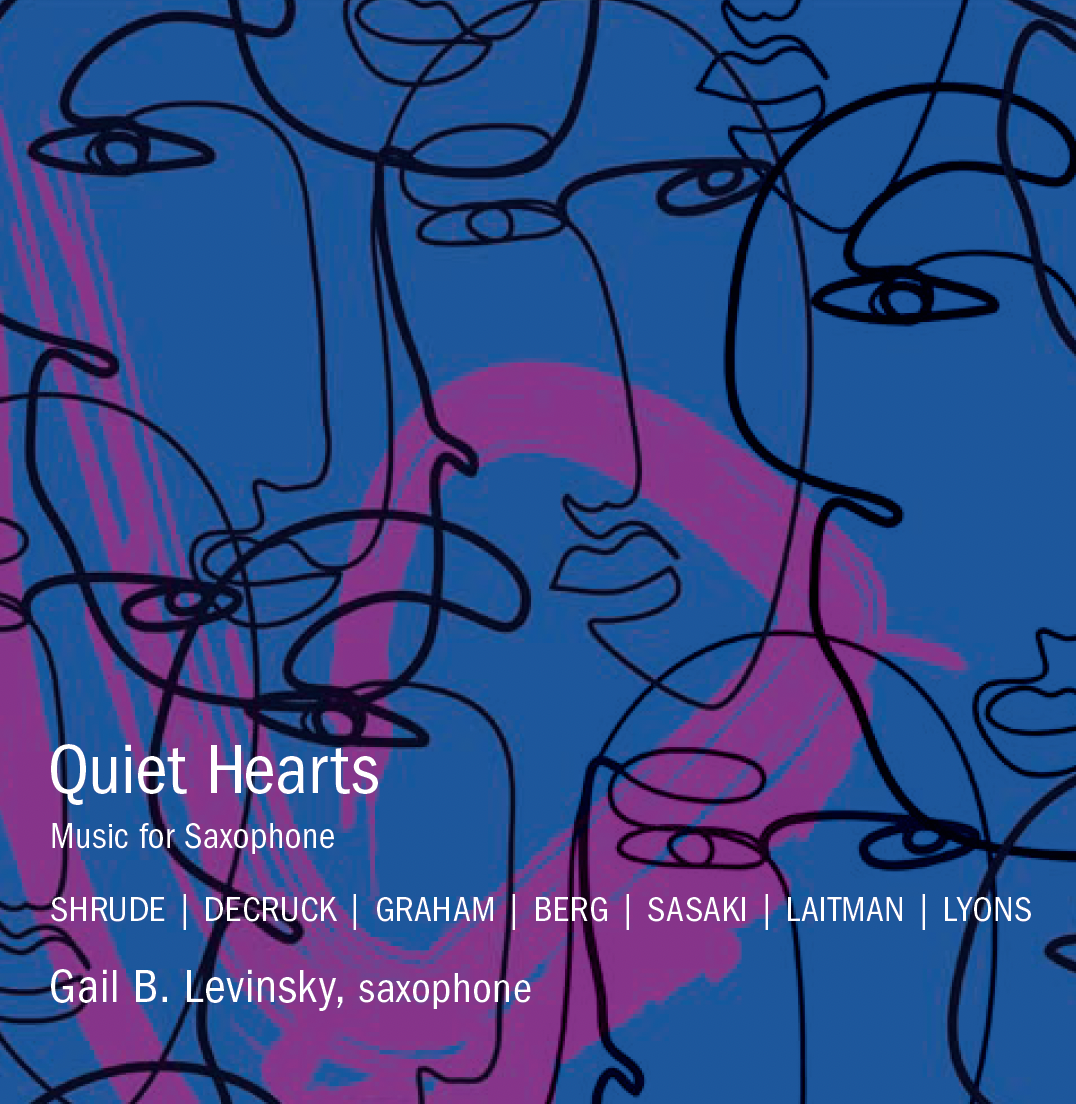ARRANGEMENTS
$10 - score & part
$10 - score & part
Contrapuntus I from the Art of the Fugue by JS Bach, arranged by Gail B Levinsky for Saxophone Quartet (SATB)
Adoration by Florence Price, arranged by Gail B Levinsky for Soprano Saxophone & Organ
O vos omnes for Saxophone Ensemble by Tomas Luis de Victoria, arranged by Gail B. Levinsky
RECORDINGS
New Release
The Woodwind Chamber Music by composer Matthew Quayle. Featuring “Sundance” for Two Alto Saxophones & Piano, and “Sonata for Alto Saxophone & Piano.
Available on all listening platforms.
New Release
Quiet Hearts: Music for Saxophone is a musical collage featuring the artistry of women and non-binary composers and performers. The compositions included were chosen for their historical and artistic value, while further trying – in a small way – to showcase in a single recording diversity in the music composition sphere. Each composition featured is uniquely powerful, meditative, and thought-provoking. As such, it is my hope for the listener to move beyond the digital performance and the beauty of the classical saxophone sonority and to reflect, explore, ponder, imagine, and discover this music intimately.
Released in 2009, “Tipping Point: Music for Saxophone and Other Voices” explores the saxophone voice in a variety of chamber settings. Features works by composers, Jason Bahr, Mark Engebretson, Matthew Quayle, and Paul Hayden.
Now available on all listening platforms.
“Conicality” was released by the Vision Quartet
Works by Adler, Xenakis, Bubalo, Foss, Karlins, Donatoni, and Steel.
VISION QUARTET
Jeremy Ruthrauff, soprano
Nance Mcmillian, alto
Dennis Lindsey, tenor
Gail Levinsky, baritone
Now available on all listening platforms.
Released in 2002, “Saxophone & Other Voices” explores the saxophone voice in a variety of chamber settings. Features works by composers, Larsen, Muczynski, Long, McConnell, and Ferko.
Now available on all listening platforms
PUBLICATIONS
-
Teaching Woodwinds: A Guide for Students and Teachers is a comprehensive resource perfectly suited for university woodwind technique classes, band directors needing woodwind details, or anyone looking for in-depth information on how to play and teach the flute, oboe, clarinet, bassoon, and saxophone.
-
This classic volume by Rosemary Lang, long out of print, has been revised and updated by Gail Levinsky, professor of music at Susquehanna University and published in a new 2010 edition. The complete title is "Beginning Studies in the Altissimo Register for Saxophone." In it, players learn how first to produce and then to master the unique altissimo register of the alto and tenor saxophone. Each unit in the book is clear and to the point, focusing on a specific altissimo note with a series of exercises followed by simple melodies that incorporate the new note. The book progresses in this way chromatically from high F# (F#) up to F (F7). The book's purpose is to teach the altissimo register quickly and efficiently, and as such, each unit is clearly focused on the altissimo aspect alone, without the clutter of other technical issues such as changing meter, tricky rhythms or non-standard tonalities. The book concludes with a set of major scales, major and minor interval studies, and a set of chromatic studies covering all 12 tones.
-
Marcos Krieger and Gail B. Levinsky
A catalog of 75 compositions for saxophone and organ.
ORDER FROM HICKEY'S MUSIC (Ithaca, NY)
REVIEW: Jonathan B. Hall, The American Organist, February 2015 -
Gail B. Levinsky, DM, Northwestern University, 1997.
ABSTRACT: This paper examines saxophone methodology published in the mid-nineteenth and early twentieth centuries by investigating the historical and pedagogical role of works published in Europe and the United States between 1846 and 1946. To further document the methods historical and educational significance, an annotated bibliography of more than 300 methods and studies published during the early history of the saxophone was compiled.
The saxophone methods included in this study reveal a wealth of information. Each method supplies instructional material on current performance practices of the period, provides biographic information on the individuals who wrote saxophone methods, and, when viewed as a single phenomenon, establishes historic, stylistic, and technical trends for how this instrument was used in its first 100 years.
Since 1845, the French and Belgian musicians in particular, have employed master artist/teachers in instructing the fundamental principles of saxophone performance, as well as providing etudes or studies for development in technical fluency, phrasing, and expression. Many of these "classic" methods remain part of the modern pedagogical literature. The American methods published in the early twentieth century were authored not only by well-known artists of the day, such as Vereecken, Henton, and Wiedoeft, but by individuals few would recognize by name. Many of these methods were independently published, no longer in print, and provided an educational resource for self-instruction without the benefit of a teacher.
Although a great deal of existing scholarship has been revealed about the history of the saxophone, it is the author's contention that the lines of development in the saxophone can be directly traced through its methods. In the early methodology, as is presently true in modern methodology, there were newly devised and individual approaches to teaching the saxophone. A number of skilled performers, both in the classical and jazz idioms, each bring forth their personal interpretation and the essential skills in playing the saxophone. By using this study as a reference, saxophone teachers can glean information from several areas and provide a better understanding of teaching practices through the saxophone's history.
PRESENTATIONS
RECENT INVITED MASTER CLASSES & CLINICS
• Jazz at the Summit, Breckenridge, CO
• Southeastern Louisiana University
• Jones Community Junior College
• Central Arkansas State University
• Bowling Green State. University
• Muskingum University
• Butler University,
• Indiana State University
• The Ohio State University
• University of Montevallo, Single Reed Day
• Heidelberg University
• Rowan University, Glassboro, NJ, Virtual















